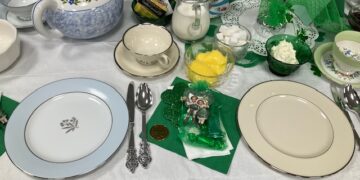
The most well-known and obvious method of preserving spring blooms is through the art of pressing. Whether you have a fancy store-bought contraption with wood, cardboard, screws and paper or an old, thick college textbook, there are many methods to utilize to achieve this outcome. If you have a flower press, make sure to have bleach-free paper of some sort to absorb the moisture of the flowers as they dry. The same goes for large, heavy books as well, but for those pages it is also advised to use paper towels to preserve the integrity of the book as well as evenly dry out the plants. If you are using a book, make sure to shut it firmly either with an old belt as a tie or by stacking it with equally heavy books to ensure even pressure and drying. This method is the longest of all of the ones I read about, topping out at up to 30 days to reach complete dryness. Flower pressing is not for those in a time crunch!
A method that I recall my mom employing when I was a child is the use of silica gel to dry out flowers. Get a large container that is deep enough to cover the flowers you would like to dry and at least several inches of drying agent. This method is especially good to use for larger flowers like roses, camellias and dahlias. Put a layer of gel down in the container, and then place the flowers you hope to dry face up on top. Add more gel overtop of the blooms but not to the point of burying them. Cover the container with an airtight lid and place in a dry place for 2-days. If the flowers are not completely dry, give them more time. Usually by a week even the thickest of plants is dry and ready for carefully removing from the container. While silica gel is not toxic, it is suggested that you wear a mask when pouring it into the container so as not to inhale particles, and also once you have finished using the container to dry plants make sure not to use it to store food as the drying process can leach out pesticides and poisons from the plants you dry. The end result of this method is fully-preserved blooms that have retained a lot of their natural color. Take caution, however, because the petals will be fragile and prone to shattering if you are not careful.
I have to admit, this next method blew my mind. I cannot believe I never thought of it before! If you need dried flowers ASAP there’s no better method than using the microwave. For this method you will need a clean rag or paper towel and a heavy microwave safe dish. Arrange the flowers and plants on half of the rag or paper towel, and fold the other half over top of the blooms. Place the folded cloth or paper in the microwave and set a heavy microwave-safe dish on top of the flowers. Microwave at half power for 90 second increments, carefully checking on them as you go. You will need to make sure the flowers are completely cool before using them, but this is by far the fastest flower drying method out there! They also maintain their bright natural colors a lot better than the other methods mentioned. Finally, another way to preserve those beautiful spring blooms is to air-dry them. This method is often used for herbs, but can preserve some of the more delicate flowers as well. Gather the flowers you wish to dry into a small bouquet and fasten them together with string or a rubber band. Hang them upside down in a cool, dark room and wait. This method, much like pressing, can take several days and even weeks. While they do a lovely job of preserving plants, keep in mind that in the time it takes for them to dry you may lose flowers and leaves in the process to try to start with a larger bouquet than you hope to finish with. The other down side to this method is that the dried flowers will be super brittle and easy to break once the process is finished. Taking them down and removing the rubber band/twine should be done as gently as possible.
As a child I have fond memories of my mom drying Baby’s Breath and other blooms between the pages of a big red Complete Works of WIlliam Shakespeare. I loved opening the book and looking for flowers inside. Dried flowers can be used to decorate cards, to frame, or just keep in a vase as house decor. If you find yourself wishing your spring blooms could last beyond their normal vase-held lifespan, try drying them out to keep for a long while longer.
































